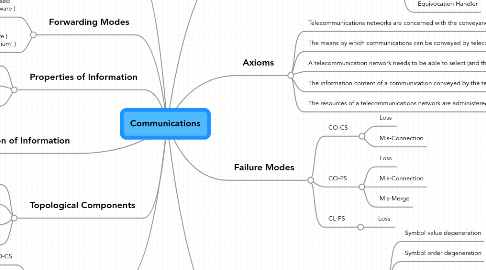Communications
by Jean-Lou Dupont


1. Basic Types of communication
1.1. List 1
1.1.1. Timed Sequence [aka stream]
1.1.2. Open Sequence [aka file]
1.1.3. Message [aka packet]
1.2. List 2
1.2.1. Sequence
1.2.1.1. Open
1.2.1.2. Closed
2. Transfer Modes
2.1. CO-CS
2.2. CO-PS
2.3. CL-PS
3. Forwarding Modes
3.1. Destination based ( destination aware )
3.2. Channel based ( destination un-aware ) ( aka 'broadcast medium' )
4. Properties of Information
4.1. Copying
4.2. Merging
4.3. Measuring
5. Identification of Information
5.1. Resource
5.2. Forwarding Point
5.3. Forwarding Address
5.4. Sequence of Next-hops
5.5. Communication Instance
5.6. Access Point
6. Topological Components
6.1. Layer Network
6.2. Subnetwork
6.3. Link
6.4. Access Group
7. Transport Processing Functions
7.1. Labeler
7.2. Encoder
7.3. Adapter
7.4. Termination
7.5. Layer Processor
7.6. Forwarder
7.7. Equivocation Handler
8. Axioms
8.1. Telecommunications networks are concerned with the conveyance of information between senders and recipients when the senders and recipients are separated geographically
8.2. The means by which communications can be conveyed by telecommunications networks (resources) is normally limited and therefore needs to be shared amongst many communications
8.3. A telecommunication network needs to be able to select (and therefore identify) a sender of a communication and to select (and therefore identify) the intended recipients of that communication
8.4. The information content of a communication conveyed by the telecommunications network is sometimes subject to loss
8.5. The resources of a telecommunications network are administered by one or more organizations
9. Failure Modes
9.1. CO-CS
9.1.1. Loss
9.1.2. Mis-Connection
9.2. CO-PS
9.2.1. Loss
9.2.2. Mis-Connection
9.2.3. Mis-Merge
9.3. CL-PS
9.3.1. Loss
10. Impairments
10.1. Symbol related
10.1.1. Symbol value degeneration
10.1.2. Symbol order degeneration
10.1.3. Symbol timing degeneration
10.1.4. Symbol delivery degeneration
10.1.5. Symbol non-delivery
10.2. Forwarding relationship related
10.2.1. Unexpected symbols (Ingress port with attached sender)
10.2.2. Symbol miss-delivery (egress port with attached receiver is added)
10.2.3. Ingress port with attached sender is removed
10.2.4. Egress port with attached receiver is removed
10.2.5. Short-break (forwarding relationship modified etc.)
